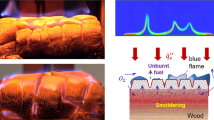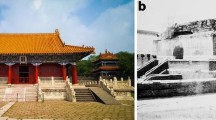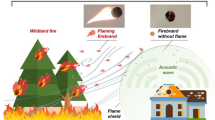Abstract
Timber is cost-effective and environmentally-friendly, which is a potential material for sustainable buildings, but its fire safety is still a significant concern. In this work, we investigate the burning behaviors of different types of woods and their self-extinction mechanism under external radiation. A unique near-limit flame is observed when the irradiation is above a critical value of about 40 kW/m2. Such a near-limit flame is weak, blue, and discrete that tends to attach to the wood residue surface, different from the normal buoyancy-controlled sooty yellow flame. If the irradiation is low (< 40 kW/m2), the yellow flame extinguishes and transits directly to smoldering at the mass flux of about 4 g/m2 s. However, above the critical irradiation level, the yellow flame transits to the blue flame that does not extinguish until the mass flux of around 1 g/m2 s, extending the flame extinction limit of timber materials. The near-limit blue flame may appear only if the char surface temperature exceeds 700°C. Two critical conditions are hypothesized for this unique blue flame, (I) in-depth pyrolysis (mainly lignin) sustained by the internal smoldering combustion, and (II) the hot surface maintained by large external radiation to extend the flammability limit. This unique blue flame may play an essential role in the transition between flaming and smoldering and help evaluate the fire risk of timber materials under real fire scenarios.
Graphical abstract









Similar content being viewed by others
References
Barber D (2015) Tall timber buildings: What’s next in fire safety ? Fire Technol 51:1279–1284
Richter F, Atreya A, Kotsovinos P, Rein G (2019) The effect of chemical composition on the charring of wood across scales. Proc Combust Inst 37:4053–4061
Richter F, Kotsovinos P, Rackauskaite E, Rein G (2021) Thermal response of timber slabs exposed to travelling fires and traditional design fires. Fire Technol 57:393–414
Crielaard R, van de Kuilen JW, Terwel K, Ravenshorst G, Steenbakkers P (2019) Self-extinguishment of cross-laminated timber. Fire Saf J 105:244–260
Song J, Chen C, Zhu S, Zhu M, Dai J, Ray U et al (2018) Processing bulk natural wood into a high-performance structural material. Nature 554:224–228
Boarin P, Calzolari M, Davoli P (2018) Two timber construction models: tradition without innovation or innovation without tradition? TECHNE 16:68–78
Drysdale D (2011) An introduction to fire dynamics, 3rd edn. Wiley, Chichester.
Prior R. The entire wooden interior of Notre Dame Cathedral has been lost. CNN 2019.
Emberley R, Inghelbrecht A, Yu Z, Torero JL (2017) Self-extinction of timber. Proc Combust Inst 36:3055–3062
Bilbao R, Mastral JF, Aldea ME, Ceamanos J, Betrán M, Lana JA (2001) Experimental and theoretical study of the ignition and smoldering of wood including convective effects. Combust Flame 126:1363–1372
Bartlett AI, Hadden RM, Bisby LA (2019) A review of factors affecting the burning behaviour of wood for application to tall timber construction. Fire Technol 55:1–49
Boonmee N, Quintiere JG (2002) Glowing and flaming autoignition of wood. Proc Combust Inst 29:289–296
Boonmee N, Quintiere JG (2005) Glowing ignition of wood: the onset of surface combustion. Proc Combus Inst 30(2):2303–2310.
Emberley R, Do T, Yim J, Torero JL (2017) Critical heat flux and mass loss rate for extinction of flaming combustion of timber. Fire Saf J 91:252–258
Moghtaderi B, Novozhilov V, Fletcher DF, Kent JH (1997) A new correlation for Bench-scale piloted ignition data of wood. Fire Saf J 29:41–59
Vermesi I, Richter F, Chaos M, Rein G (2021) Ignition and burning of fibreboard exposed to transient irradiation. Fire Technol 57:1095–1113
Shi L, Chew MYL (2012) Influence of moisture on autoignition of woods in cone calorimeter. J Fire Sci 30:158–169
Huang X, Li K, Zhang H (2017) Modelling bench-scale fire on engineered wood: Effects of transient flame and physicochemical properties. Proc Combust Inst 36:3167–3175
Richter F, Rein G (2019) Heterogeneous kinetics of timber charring at the microscale. J Anal Appl Pyrol 138:1–9
Richter F, Rein G (2020) A multiscale model of wood pyrolysis to study the role of chemistry and heat transfer at the mesoscale. Combust Flame 216:316–325
Rein G (2014) Smoldering Combustion. SFPE Handbook Fire Protection Eng 2014:581–603
Gratkowski MT, Dembsey NA, Beyler CL (2006) Radiant smoldering ignition of plywood. Fire Saf J 41:427–443
Wang S, Ding P, Lin S, Huang X, Usmani A (2021) Deformation of wood slice in fire: Interactions between heterogeneous chemistry and thermomechanical stress. Proc Combust Inst 38:5081–5090
Lin S, Sun P, Huang X (2019) Can peat soil support a flaming wildfire? Int J Wildland Fire 28:601–613
Bartlett AI, Hadden RM, Hidalgo JP, Santamaria S, Wiesner F, Bisby LA et al (2017) Auto-extinction of engineered timber: application to compartment fires with exposed timber surfaces. Fire Saf J 91:407–413
Richter F, Jervis FX, Huang X, Rein G (2021) Effect of Oxygen on the Charring Rate of Wood. Combust Flame (accepted)
Cuevas J, Torero JL, Maluk C (2021) Flame extinction and burning behaviour of timber under varied oxygen concentrations. Fire Saf J 120:103087
Arnórsson SM, Hadden RM, Law A (2021) The variability of critical mass loss rate at auto-extinction. Fire Technol 57:233–246
Babrauskas V (2002) Journal of fire protection ignition of wood: a review of the State of the Art. J Fire Prot Eng 12:163–189
Smucker BD, Mulky TC, Cowan DA, Niemeyer KE, Blunck DL (2019) Effects of fuel content and density on the smoldering characteristics of cellulose and hemicellulose. Proc Combust Inst 37:4107–4116
Santoso MA, Christensen EG, Yang J, Rein G (2019) Review of the transition from smouldering to flaming combustion in wildfires. Front Mech Eng 5:49
The BV, Calorimeter C (2016) In: Hurley M (ed) SFPE Handb Fire Prot Eng. 5th edn. Springer, London, pp 952–980
Fuentes A, Legros G, Claverie A, Joulain P, Vantelon JP, Torero JL (2007) Interactions between soot and CH* in a laminar boundary layer type diffusion flame in microgravity. Proc Combust Inst 31(2):2685–2692
Rich D, Lautenberger C, Torero JL, Quintiere JG, Fernandez-Pello C (2007) Mass flux of combustible solids at piloted ignition. Proc Combust Inst 31(2):2653–2660
Delichatsios MA, Delichatsios MM (1997) Critical mass pyrolysis rates for extinction of fires over solid materials. Fire Saf Science 5:153–164
Delichatsios MA (2005) Piloted ignition times, critical heat fluxes and mass loss rates at reduced oxygen atmospheres. Fire Saf J 40:197–212
Moghtaderi B, Novozhilov V, Fletcher DF, Kent JH (2006) A new correlation for Bench-scale piloted ignition data of wood. Fire Saf J 29:41–59
Rein G, Cohen S, Simeoni A (2009) Carbon emissions from smouldering peat in shallow and strong fronts. Proc Combust Inst 32:2489–2496
Wu D, Schmidt M, Huang X, Verplaetsen F (2017) Self-ignition and smoldering characteristics of coal dust accumulations in O2/N2 and O2/CO2 atmospheres. Proc Combust Inst 36:3195–3202
Stefanidis SD, Kalogiannis KG, Iliopoulou EF, Michailof CM, Pilavachi PA, Lappas AA (2014) A study of lignocellulosic biomass pyrolysis via the pyrolysis of cellulose, hemicellulose and lignin. J Anal Appl Pyrol 105:143–150
Lin K-C, Faeth GM (2000) State relationships of laminar permanently-blue opposed-jet hydrocarbon-fueled diffusion flames. Int J Environ Combust Tech I:53–79
Lin KC, Faeth GM (1995) Hydrodynamic suppression of soot emissions in laminar diffusion flames. In: 33rd Aerospace Sciences Meeting and Exhibit,12:10–17.
Acknowledgements
This work is supported by the National Key Research and Development Plan under Grant no. 2020YFC1522800, the National Natural Science Foundation of China (No. 51876183, 51806230), and the SKLFS Open Fund (No. HZ2019-KF02).
Author information
Authors and Affiliations
Corresponding authors
Additional information
Publisher's Note
Springer Nature remains neutral with regard to jurisdictional claims in published maps and institutional affiliations.
Electronic supplementary material
Below is the link to the electronic supplementary material.
Video S1 Ignition & burning of wood C (30 kW) (MP4 6474 kb)
Video S2. Ignition & burning of wood C (60 kW) (MP4 13756 kb)
Video S3. Irradiation on the near-limit blue flame. (MP4 7952 kb)
Appendix
Appendix
The wood and PMMA sample were pulverized into powders and dried at 70°C for 48 h. The thermal analysis was conducted with a PerkinElmer STA 6000 Simultaneous Thermal Analyzer. The initial mass was about 3 mg, and samples were heated at the constant rates of 30 K/min. Two oxygen concentrations were selected, 0% (nitrogen) and 21% (air), with a flow rate of 50 mL/min. Experiments were repeated twice for each case, and good repeatability is shown. As compared in Fig. 9, the decomposition both started at more than 200°C, while the DTG curve of wood is much wider than that of PMMA. Clearly, the reaction of PMMA already finished right below 500°C. For the DTG curve of wood, the decomposition of wood (especialy the lignin component) can still exist above 600°C. Figures 10, 11, 12 show the evolutions of mass flux, heat release rate and surface temperature of wood C under different external radiations.
Figure 13 shows the mass flux and temperature evolution of PMMA under the external radiant heat flux of 60 kW/m2. The mass flux evolution of PMMA is different from that of wood in Fig. 5. For PMMA, the mass flux approximately sustained at 20 g/m2 s during burning, and the extinction occurred due to the burnout of fuel. In Fig. 13b, during the flaming combustion, the top surface temperature was measured to be constant at about 400°C before the burnout. The value is also close to final temperature of DTG in Fig. 9b.
Rights and permissions
About this article
Cite this article
Lin, S., Huang, X., Gao, J. et al. Extinction of Wood Fire: A Near-Limit Blue Flame Above Hot Smoldering Surface. Fire Technol 58, 415–434 (2022). https://doi.org/10.1007/s10694-021-01146-6
Received:
Accepted:
Published:
Issue Date:
DOI: https://doi.org/10.1007/s10694-021-01146-6









